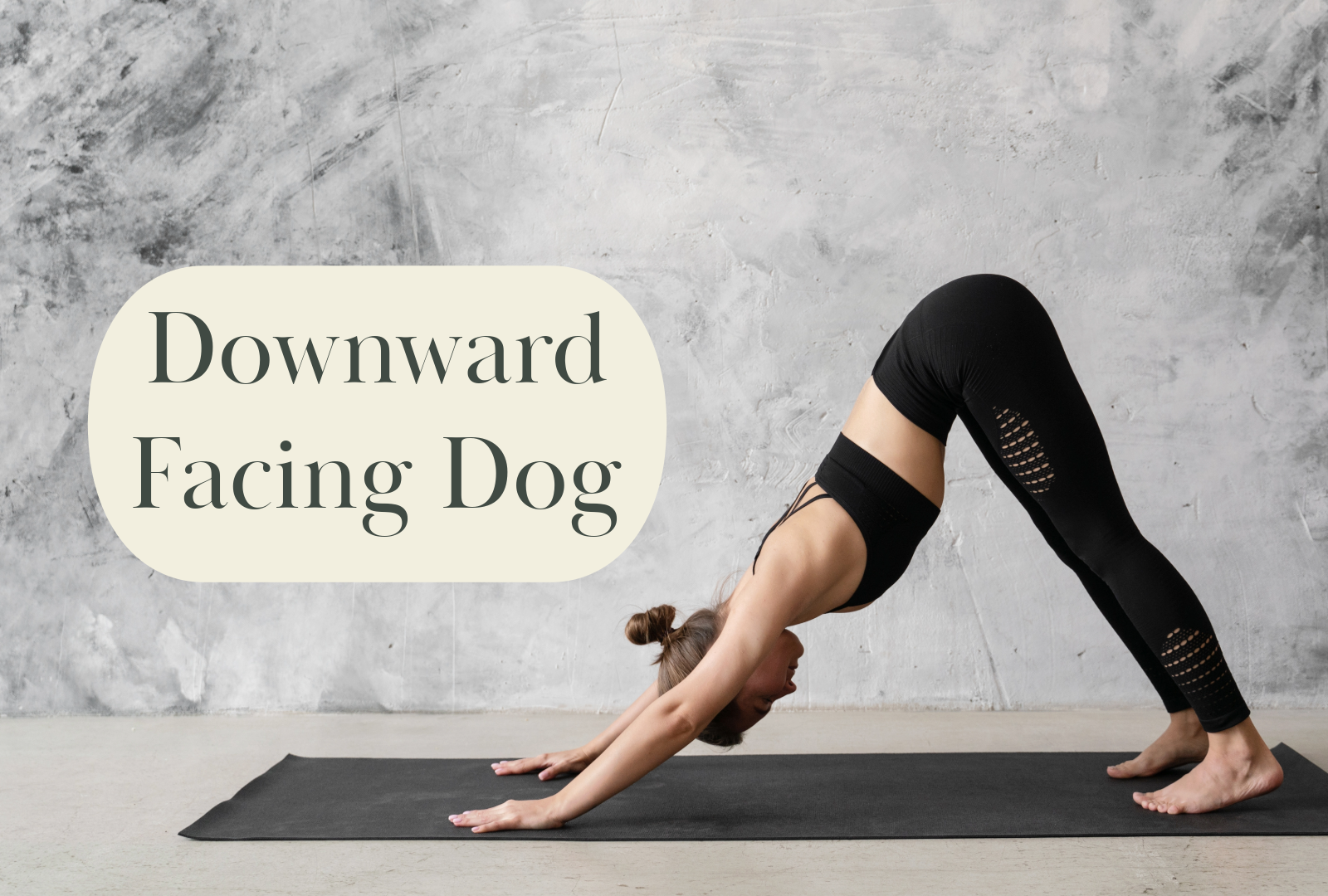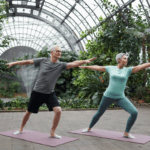Coming Soon: E-book about Kundalini Yoga - Sign up here to be among the first to get it!
Sanskrit: Adho Mukha Svanasana
Type: Forward bend, Inversion
Chakra Involved: Third Eye Chakra (Ajna Chakra), Throat Chakra (Vishuddha Chakra), Heart Chakra (Anahata Chakra), Solar Plexus (Manipura Chakra)
The Downward Facing Dog Pose, known in Sanskrit as Adho Mukha Svanasana, is one of the most recognized and widely practiced yoga poses due to its numerous benefits. It stretches and strengthens the entire body, improves circulation, and can help relieve stress. This pose is often used as a transitional pose, a resting pose, and a strength-builder in many yoga sequences.
Starting Position
Before moving into the Downward Facing Dog, start on your hands and knees on your yoga mat. Ensure your knees are directly below your hips and your hands are slightly forward of your shoulders. Spread your palms, index fingers parallel or slightly turned out, and press firmly through your hands and forearms.
Step-by-step Instruction
- Exhale and Lift: As you exhale, lift your knees away from the floor, initially keeping the knees slightly bent and the heels lifted away from the floor.
- Lengthen Your Spine: Press the floor away from you as you lengthen your spine. Lift your sit bones up toward the ceiling.
- Straighten Legs (Optional): Gradually straighten your legs, but do not lock your knees. Bring your body into the shape of an “A.”
- Ground Your Heels: Try to lower your heels toward the floor to deepen the stretch in the back of your legs.
- Align Your Head: Keep your head between your arms, without letting it hang, and gaze toward your feet.
- Hold the Pose: Stay in this position for 1-3 minutes, focusing on maintaining a steady breath.
To Release the Pose
- Bend Your Knees: On an exhale, gently bend your knees and lower them back to the floor.
- Rest: Transition into Child’s Pose (Balasana) by sitting back on your heels, stretching your arms forward, and resting your forehead on the floor. This allows your body to rest and your spine to neutralize after the intense stretch.
Teacher’s Tip
To get the most out of the Downward Facing Dog Pose, focus on distributing your weight evenly between your hands and feet. Engage your arms and legs by actively pressing through your palms and heels. If your heels don’t reach the floor, don’t worry; focus on lengthening your spine and lifting your hips. Over time, with practice, flexibility will improve.
Remember, yoga is about progress, not perfection. Listen to your body, and modify the pose as needed to accommodate your level of flexibility and strength.
Variations of Downward Facing Dog Pose (Adho Mukha Svanasana)
Downward Facing Dog is a versatile pose with several variations to accommodate different levels of flexibility, strength, and specific focus areas. Here are some popular variations and instructions for each:
1. Bent Knee Downward Facing Dog
- Instructions: Begin in the traditional Downward Facing Dog position. Then, intentionally bend your knees slightly, focusing on lengthening your spine and lifting your hips higher. This variation helps maintain spinal alignment and eases tension in the lower back.
2. Three-Legged Downward Facing Dog (Eka Pada Adho Mukha Svanasana)
- Instructions: From Downward Facing Dog, lift one leg up towards the ceiling, keeping your hips square to the ground. This variation increases strength and flexibility in the supporting leg and opens up the hips of the lifted leg.
3. Downward Facing Dog with a Twist
- Instructions: From the standard pose, lift your right hand off the ground and reach for your left ankle, looking under your left shoulder. This adds a twisting motion, stretching the spine and shoulders. Return to the center and switch sides.
4. Downward Facing Dog Against the Wall
- Instructions: Place your hands on the wall at hip height, stepping back until your body forms a right angle. Push into the wall as you lift your hips back and up. This variation is excellent for beginners or those with wrist discomfort, offering the pose’s benefits with less strain.
5. Downward Facing Dog on Chair
- Instructions: Place your hands on the seat of a chair, stepping your feet back until your chest is parallel to the ground. This provides a gentle inversion, suitable for those with high blood pressure or wrist issues.
6. Wide-Legged Downward Facing Dog
- Instructions: Step your feet wider than hip-distance apart in the Downward Facing Dog pose. This increases the stretch in the inner thighs and groin area, offering a deeper hip opening.
7. Downward Facing Dog with Heel Lift
- Instructions: From the standard Downward Facing Dog, alternately lift your heels high, then press them down towards the mat. This “walking the dog” motion helps warm up and stretch the calves and hamstrings.
Implementation Tips
- Warm-Up: Ensure your body is adequately warmed up before attempting variations, especially those requiring more flexibility or strength.
- Alignment: Pay close attention to alignment in each variation to maximize benefits and minimize the risk of injury.
- Breath: Maintain a steady, even breath throughout each pose to enhance focus and relaxation.
- Modifications: Use props like yoga blocks, straps, or the wall to modify poses for better accessibility or to deepen the stretch.
Experimenting with these variations can keep your practice interesting and challenging, addressing different body areas and personal needs.
FAQs About Downward Facing Dog
Downward Facing Dog (Adho Mukha Svanasana) is a multifaceted yoga pose with numerous benefits, including:
- Strengthens the Upper Body: It builds strength in the shoulders, arms, and upper back.
- Stretches the Lower Body: Offers a deep stretch to the hamstrings, calves, and Achilles tendons, and even the arches of your feet.
- Improves Circulation: Being an inversion, it helps increase blood flow to the brain, which can boost energy levels and improve concentration.
- Enhances Flexibility: Regular practice increases flexibility in the spine, shoulders, and hips.
- Relieves Back Pain: By elongating the spine, it can help relieve tension and pain in the back.
- Therapeutic for High Blood Pressure: The inverted nature can help manage high blood pressure, though it should be practiced with caution and under guidance if you have this condition.
- Aids Digestion: The folding motion can help stimulate digestive organs.
- Calms the Mind: Helps relieve stress, mild depression, and anxiety when practiced with focused, deep breathing.
While beneficial for many, certain individuals should avoid or modify Downward Facing Dog, including those with:
- Severe Carpal Tunnel Syndrome: The pose places weight on the wrists, which can aggravate symptoms.
- High Blood Pressure or Heart Conditions: The inversion can affect blood pressure; those with these conditions should consult a healthcare provider.
- Late-term Pregnancy: As the belly grows, the pose may become uncomfortable, requiring modifications or alternative poses.
- Severe Eye Conditions: Such as glaucoma, where increased pressure to the head and eyes is not recommended.
- Recent or Chronic Injury: To the back, shoulders, or arms, where the pose could exacerbate the condition.
- Start on Your Hands and Knees: With hands slightly forward of your shoulders and knees under your hips.
- Lift Your Hips: Exhale and lift your knees off the floor, reaching your pelvis up toward the ceiling.
- Straighten Your Legs: Gradually straighten your legs, but don’t lock your knees. Bring your body into the shape of an “A.”
- Distribute Your Weight Evenly: Press firmly through your palms and fingers while directing your weight back towards your legs.
- Align Your Ears with Your Arms: Keep your head between your arms, careful not to let it hang, maintaining a neutral neck.
- Hold the Pose: Maintain for several breaths, aiming for a balanced distribution of weight through your arms and legs.
Downward Facing Dog can be challenging due to several factors:
- Strength and Flexibility: It requires a combination of upper body strength, hamstring flexibility, and shoulder flexibility that many beginners may not have developed.
- Balance and Alignment: Achieving and maintaining the correct alignment while balancing the body’s weight between the hands and feet can be difficult without practice.
- Physical Conditions: Pre-existing conditions like tight hamstrings, weak upper body, wrist pain, or shoulder stiffness can make the pose more challenging.
- Adjustment Period: It often takes time for beginners to get used to the inverted nature of the pose and to build the endurance needed to hold it comfortably for extended periods.
Practicing Downward Facing Dog regularly, along with targeted strengthening and stretching exercises, can help overcome these difficulties over time.




